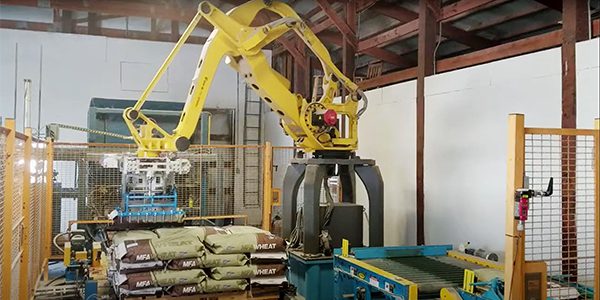

An Investigation into Robotic Palletizing in Agricultural Feed Mills and Co-Ops
Revenue is correlated directly to efficiency. The more efficient a feed mill or co-op, the more revenue generated. Yet, many agricultural processing facilities follow processes that get them by for now. These are known as “good-enough” processes.
Assumptions that production line innovation, like robotic palletizing, is too costly and/or too large to fit in an already tight space dominate the industry.
Given the challenges facing feed mills and co-ops today, it can make more sense to replace good-enough processes with automation to improve profitability and overall production.
Do any of following scenarios apply to your agricultural processing facility?
You know or suspect you’re missing out on new business and orders. There are several factors driving demand today. Supply and demand problems in resources and people force plants nationwide to limit full production capabilities. This coupled with post-pandemic consumers’ expectations to receive orders faster than ever creates a need to improve efficiencies wherever possible.
Meeting demand is a challenge in the production industry as a whole. Facilities able to fulfill orders on time are winning more business. In the midst of a labor-shortage, meeting demand isn’t a matter of hiring more employees. It’s automating labor-intensive processes on the line, including end-of-the-line robotic palletizing.
Labor. Period. Like every other industry, agricultural feed mills and co-ops are feeling the labor shortage crunch, even more so now than before the Great Resignation. They struggle to hire and retain employees, and thus are operating short staffed. Even when able to hire employees, facilities can still experience the consequences of relying on manual labor. Skeleton crews rarely can operate 24/7/365. And, of course, they need breaks, sick days and vacation time.
Making labor challenges even tougher is the fact that end-of-the-line palletizing is physically challenging work. When able to find employees willing to fill palletizing positions, there always is the increased potential for injuries caused by heavy lifting and repetitive movements, which leads to workers’ compensation claims. Not to mention, having to start the hiring and training process all over again. Production planning becomes nearly impossible.
What happens when your pallets don’t get out the door and on the truck on time? In addition to struggling to hire labor and the increased potential for injuries to those palletizing at the end of the line, you know you have to hit your delivery dates or risk losing your customers’ trust and their business.
Your employees are humans, and inevitably, humans make mistakes. Every pallet of product sent back is revenue down the drain. And, there is a lot that can go wrong, leading to delivery refusals and returns.
For example, agricultural products’ temperatures at the end-of-the-line palletizing point can run 80-90° Fahrenheit, which when combined with moisture, creates an environment suited for mold growth. These conditions alone require a careful and precise stacking configuration that allows for air circulation. Also, there may be different bag sizes to manage and change, which is time consuming. Finally, human strength fades as the shift hours go by, leading to inconsistent bag placement, labels facing the wrong direction, pallets with leaning bags, and bag contents shaken more than necessary.
How Much Time, Business and Revenue Are at Risk by Not Replacing Good-Enough Processes with Robotic Palletizing?
There are the numbers associated with your current manual palletizing processes you know, like end-of-the-line palletizing time, number of bags processed per day, how many orders your facility can and cannot handle, etc. There are numbers you can estimate and plan for, such as costs of recruiting and training employees, average number of workers’ compensation claims, average number of pallets returned, etc. What if investing in robotic palletizing improved the numbers you know and made estimating unnecessary?
Only you know if your facility is ready to automate with robotic palletizing. If any or all of the above scenarios apply, it’s worth having a conversation about. Magnum Systems designs, engineers and installs customized robotic palletizing systems for feed mills and co-ops proven to deliver a measurable return on investment compared to the cost of lost efficiency and revenue due to growing demand, labor challenges and human mistakes.
A robotic palletizing system is programmed to keep up with demand, handle heavy weights and exactly follow a stacking configuration. This level of efficiency and consistency drives revenue by shortening lead times, replacing palletizing workers who can then fill other critical positions and delivering products as promised and on time.
Learn more about our palletizing systems or connect with a Magnum Systems expert to discuss your facility’s needs.